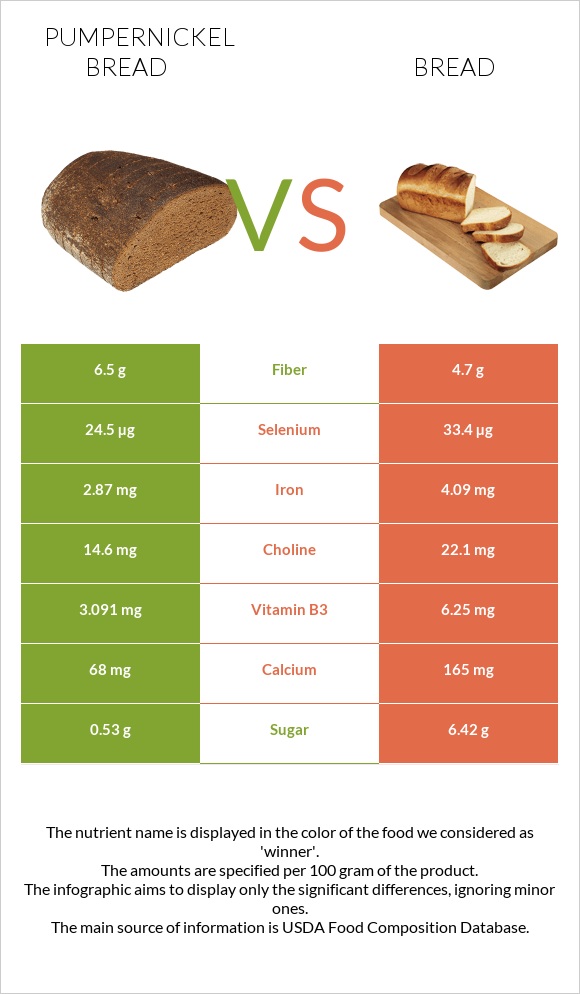Pumpernickel bread vs. Wheat Bread — In-Depth Nutrition Comparison
Compare
How are pumpernickel bread and wheat Bread different?
- Pumpernickel bread is higher in copper and fiber; however, wheat Bread is richer in vitamin B3, selenium, iron, calcium, vitamin B1, and vitamin B2.
- Daily need coverage for vitamin B3 for wheat Bread is 20% higher.
- Pumpernickel bread has less sugar.
- Pumpernickel bread has a lower glycemic index (49) than wheat Bread (60).
Bread, pumpernickel and Bread, wheat, toasted are the varieties used in this article.
Infographic

Infographic link
Mineral Comparison
Mineral comparison score is based on the number of minerals by which one or the other food is richer. The "coverage" charts below show how much of the daily needs can be covered by 300 grams of the food.
| Contains more CopperCopper | +44.9% |
| Contains more CalciumCalcium | +142.6% |
| Contains more IronIron | +42.5% |
| Contains more SeleniumSelenium | +36.3% |
Vitamin Comparison
Vitamin comparison score is based on the number of vitamins by which one or the other food is richer. The "coverage" charts below show how much of the daily needs can be covered by 300 grams of the food.
| Contains more Vitamin EVitamin E | +75% |
| Contains more Vitamin CVitamin C | +∞% |
| Contains more Vitamin B1Vitamin B1 | +34.3% |
| Contains more Vitamin B2Vitamin B2 | +25.2% |
| Contains more Vitamin B3Vitamin B3 | +102.2% |
| Contains more Vitamin B5Vitamin B5 | +12.9% |
| Contains more Vitamin B6Vitamin B6 | +21.4% |
| Contains more Vitamin KVitamin K | +612.5% |
| Contains more CholineCholine | +51.4% |
All nutrients comparison - raw data values
| Nutrient |  |
 |
DV% diff. |
| Vitamin B3 | 3.091mg | 6.25mg | 20% |
| Selenium | 24.5µg | 33.4µg | 16% |
| Iron | 2.87mg | 4.09mg | 15% |
| Calcium | 68mg | 165mg | 10% |
| Copper | 0.287mg | 0.198mg | 10% |
| Protein | 8.7g | 12.96g | 9% |
| Vitamin B1 | 0.327mg | 0.439mg | 9% |
| Fiber | 6.5g | 4.7g | 7% |
| Vitamin B2 | 0.305mg | 0.382mg | 6% |
| Vitamin K | 0.8µg | 5.7µg | 4% |
| Manganese | 1.305mg | 1.377mg | 3% |
| Polyunsaturated fat | 1.237g | 1.72g | 3% |
| Saturated fat | 0.437g | 0.989g | 3% |
| Calories | 250kcal | 313kcal | 3% |
| Carbs | 47.5g | 55.77g | 3% |
| Vitamin B6 | 0.126mg | 0.153mg | 2% |
| Fats | 3.1g | 4.27g | 2% |
| Folate | 93µg | 86µg | 2% |
| Phosphorus | 178mg | 188mg | 1% |
| Vitamin E | 0.42mg | 0.24mg | 1% |
| Choline | 14.6mg | 22.1mg | 1% |
| Magnesium | 54mg | 59mg | 1% |
| Vitamin B5 | 0.404mg | 0.456mg | 1% |
| Vitamin C | 0mg | 0.2mg | 0% |
| Net carbs | 41g | 51.07g | N/A |
| Potassium | 208mg | 223mg | 0% |
| Sugar | 0.53g | 6.42g | N/A |
| Zinc | 1.48mg | 1.47mg | 0% |
| Sodium | 596mg | 601mg | 0% |
| Monounsaturated fat | 0.932g | 1.019g | 0% |
| Tryptophan | 0.097mg | 0.092mg | 0% |
| Threonine | 0.267mg | 0.299mg | 0% |
| Isoleucine | 0.334mg | 0.258mg | 0% |
| Leucine | 0.602mg | 0.461mg | 0% |
| Lysine | 0.248mg | 0.215mg | 0% |
| Methionine | 0.155mg | 0.105mg | 0% |
| Phenylalanine | 0.422mg | 0.315mg | 0% |
| Valine | 0.396mg | 0.31mg | 0% |
| Histidine | 0.196mg | 0.15mg | 0% |
| Omega-3 - ALA | 0.161g | N/A |
Macronutrient Comparison
Macronutrient breakdown side-by-side comparison
Protein:
8.7 g
Fats:
3.1 g
Carbs:
47.5 g
Water:
37.9 g
Other:
2.8 g
Protein:
12.96 g
Fats:
4.27 g
Carbs:
55.77 g
Water:
24.23 g
Other:
2.77 g
| Contains more WaterWater | +56.4% |
| Contains more ProteinProtein | +49% |
| Contains more FatsFats | +37.7% |
| Contains more CarbsCarbs | +17.4% |
~equal in
Other
~2.77g
Fat Type Comparison
Fat type breakdown side-by-side comparison
Saturated fat:
Sat. Fat
0.437 g
Monounsaturated fat:
Mono. Fat
0.932 g
Polyunsaturated fat:
Poly. Fat
1.237 g
Saturated fat:
Sat. Fat
0.989 g
Monounsaturated fat:
Mono. Fat
1.019 g
Polyunsaturated fat:
Poly. Fat
1.72 g
| Contains less Sat. FatSaturated fat | -55.8% |
| Contains more Poly. FatPolyunsaturated fat | +39% |
~equal in
Monounsaturated fat
~1.019g





